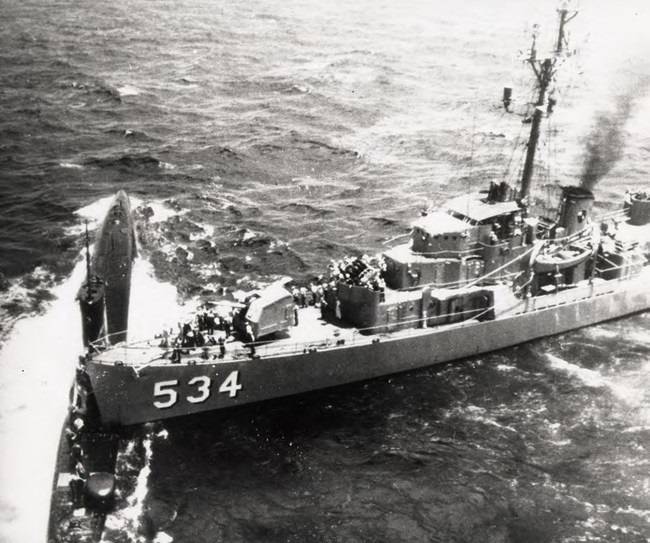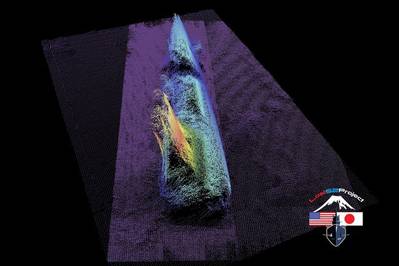Sunken Submarine USS Stickleback Found
A World War II era submarine sunk during a Cold War training exercise off the shores of Hawaii more than six decades ago has been discovered by a team of ocean explorers utilizing pioneering robotics and methods at the forefront of today's underwater technology.
USS Stickleback (SS 415), lost in nearly 11,000 feet of water 62 years ago, was discovered by veteran ocean explorer and Tiburon Subsea CEO Tim Taylor and his "Lost 52 Project" team equipped with a combination of autonomous underwater vehicles (AUV), remotely operated vehicles (ROV) and advanced photogrammetry imaging technology.
In nine years, Taylor and his team have discovered six U.S. submarines and amassed the most comprehensive historical archaeological records to date.
The WWII submarine Stickleback, commissioned on March 29, 1945, was deployed to Guam and began her first war patrol on August 6 when she departed for the Sea of Japan. She arrived the following week and began her patrol. During this timeframe, the atomic bombs had been dropped on Hiroshima and Nagasaki and it was believed the war would end shortly.
Stickleback had only been in the patrol area for two days when the cease-fire order was passed. She remained in the area and, on August 21, she sighted two bamboo rafts containing 19 survivors of a freighter. They were taken on board for 18 hours, given food, water, medical treatment, and set afloat again a short distance from one of the Japanese islands.
Stickleback returned to Guam on September 9, 1945. She departed for the United States the next day. She arrived in San Francisco and participated in the Third Fleet parade on September 28. After a short cruise to the Hawaiian Islands, Stickleback was decommissioned and placed in reserve on June 26, 1946.
Stickleback was recommissioned on September 6, 1951 and served at San Diego as a training ship. It was decommissioned a second time on November 14, 1952 and converted into a Guppy IIA type submarine. Recommissioned on June 26, 1953, Stickleback joined Submarine Squadron 7 at Pearl Harbor. Stickleback supported the United Nations forces in Korea from February to July 1954 when she returned to Pearl Harbor. From 1954 to 1957, she conducted intelligence gathering operations off of the Soviet Union.
On May 28, 1958, Stickleback was participating in an antisubmarine warfare exercise with the destroyer escort USS Silverstein (DE 534) and a torpedo retriever in the Hawaiian area.
In the course of these drills, the submarine had just completed a simulated torpedo run on Silverstein and was diving to a safe depth when she lost power and descended uncontrolled to close to 800 feet. Emergency buoyancy ballast was added, and the boat ascended rapidly only to breach approximately 180 meters ahead of the destroyer escort. On the assent a flare could not be fired as crew had evacuated the aft torpedo room. The collision alarm sounded, and Silverstein backed full, put her rudder hard left but could not avoid a collision. The result of which was a hole to the submarine on her port side and loss of the submarine.
 USS Stickleback Collision with Destroyer EscortUSS Silverstein (Photo: The Lost 52 Project)
USS Stickleback Collision with Destroyer EscortUSS Silverstein (Photo: The Lost 52 Project)
Remarkably there were no fatalities. The Stickleback's crew was removed by the torpedo retriever and combined efforts were made by several vessels to save the submarine. The rescue ships attached lines around her, but all compartments flooded, and Stickleback sank in 3,300 meters of water.
Stickleback is the third submarine to be discovered of the four US Navy submarines lost since the end of World War II. USS Cochino (SS 345), USS Thresher (SSN 593), and USS Scorpion (SSN 589) were also lost during the Cold War.
"The Lost 52 Project continues to expand our work to search for additional lost WWII ships. Having just made the historical discovery of the USS Grayback and the final resting place of her 80 valiant crew offshore Japan, I am proud of this recent Cold War discovery which honors the men, their memory and their mission," Taylor said.
"We're grateful for the respectful, nonintrusive work of the Lost 52 Project to locate and document the Navy's submarine wrecks," said Dr. Bob Neyland, Naval History and Heritage Command's Underwater Archeology Branch head. "Each discovery assists the Naval History and Heritage Command in its mission to preserve and protect the Navy's sunken military craft and provides an opportunity to remember and honor the service of our Sailors and Marines."
The Discovery of the Stickleback is part of the ongoing "Lost 52 Project" supported in part by STEP Ventures and has been recognized by JAMSTEC (Japan Agency for Marine-Earth Science and Technology) as the first and most comprehensive offshore underwater archaeological expedition in Japanese waters.















